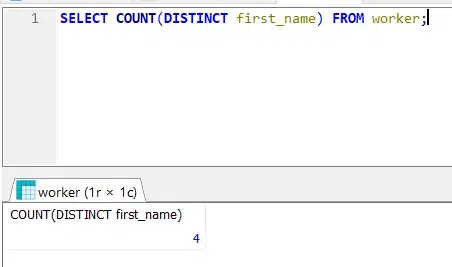DISTINCT Clause in MariaDB
Last Updated :
01 Dec, 2023
MariaDB uses SQL (Structured Query Language) and is an open-source relational database management system (RDBMS) for managing and manipulating data. With the help of the MariaDB DISTINCT clause, you can efficiently extract unique values from a given column or collection of columns in query results. In SELECT queries, this clause is frequently used to remove duplicate rows and show only unique data. Let's examine the specifics of MariaDB's DISTINCT clause.
DISTINCT Clause
To remove duplicate records from the result set, the SELECT query is used with the MariaDB DISTINCT clause.
Syntax:
SELECT DISTINCT col1, col2,….. FROM table_name;
- SELECT keyword: list the columns from which you wish to extract unique values.
- DISTINCT keyword: comes right after the SELECT keyword and the database engine is instructed to deliver only unique values for the designated columns.
Create Table
Query:
CREATE TABLE worker (
worker_id INT AUTO_INCREMENT PRIMARY KEY,
first_name VARCHAR(50),
last_name VARCHAR(50),
department VARCHAR(50),
salary DECIMAL(10, 2),
Hire_date DATE
);
Insert Data
Query:
INSERT INTO worker (first_name, last_name, department, salary, hire_date)
VALUES
('Minal', 'Pandey', 'IT', 60000.00, '2022-01-15'),
('Kavya', 'Sharma', 'HR', 55000.00, '2022-02-20'),
('Kavya', 'Sharma', 'Finance', 70000.00, '2022-03-10'),
('Asad', 'Mohammad', 'Marketing', 62000.00, '2022-04-05'),
('Vivek', 'Sharma', 'IT', 65000.00, '2022-05-12');
Example 1: To Extract Unique Departments
Query:
SELECT DISTINCT department FROM worker;
This query will retrieve a list of unique department from worker table.
Output:
 DISTINCT Clause
DISTINCT Clause
Example 2: Count the Number of Unique Values in first_name Column
Query:
SELECT COUNT(DISTINCT first_name) FROM worker;
This query will count the unique first_name in the worker table.
Output:
 DISTINCT Clause
DISTINCT Clause
Example 3: Remove Duplicates From the Table
Query:
SELECT DISTINCT first_name FROM worker WHERE first_name='Kavya';
This query will distinct first_name from the worker table where the condition is first_name should be Kavya.
Output:
 DISTINCT Clause
DISTINCT Clause
Example 4: Find Unique Hire Dates
Query:
SELECT DISTINCT DATE(hire_date) AS unique_hire_date FROM worker;
This query will retrieve a list of unique hire dates from the worker table aliasing the result as unique_hire_date.
Output:
 DISTINCT Clause
DISTINCT Clause
Example 5: List of Employees Get Hired in Particular Year
Query:
SELECT DISTINCT first_name, last_name, hire_date FROM worker WHERE YEAR(hire_date) = 2022;
This query will give the list of employees who were hired in the year 2022.
Output:
 DISTINCT Clause
DISTINCT Clause
Conclusion
A useful tool in MariaDB for extracting unique values from a dataset is the DISTINCT clause. Writing more accurate and efficient queries can be achieved by using DISTINCT, regardless of the size of the database you are dealing with. To optimize your query results, consider the unique requirements of your application and use the DISTINCT clause tactfully.
Similar Reads
MySQL DISTINCT Clause When working with databases, you often need to filter out duplicate records to get a clear and accurate result set. MySQL offers a straightforward solution for this with the DISTINCT clause. This clause helps you retrieve only unique rows from your query results, making it an essential tool for data
4 min read
MariaDB Having Clause The HAVING clause is crucial for filtering and aggregating data in database queries. The MariaDB HAVING clause syntax is outlined. It breaks down into components. These include the SELECT clause, aggregate functions, and the GROUP BY clause. The SELECT clause specifies columns. Aggregate functions p
6 min read
SQL Distinct Clause The SQL DISTINCT keyword is used in queries to retrieve unique values from a database. It helps in eliminating duplicate records from the result set. It ensures that only unique entries are fetched. Whether you're analyzing datasets or performing data cleaning, the DISTINCT keyword is Important for
4 min read
MariaDB Function MariaDB is an open-source relational database management system that stores organize and manipulate data very efficiently. It is considered a replacement for MySQL. It offers various features like multi-master replication, enhanced storage engines, and so on. In this article, we will learn about the
6 min read
MariaDB COUNT Functions MariaDB is an open-source and relational database to operates available data and displays the required value. the count, max, min, and other functions used to get particular information or count of the database data. the mariaDB count() function is used to get a COUNT of the row or available informa
4 min read